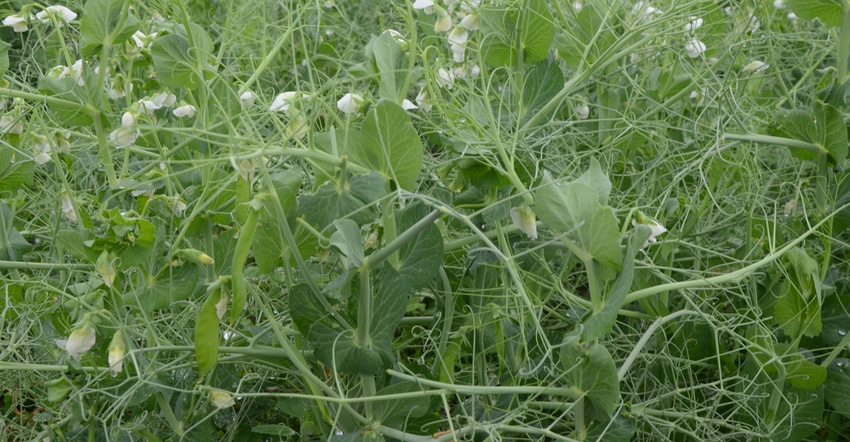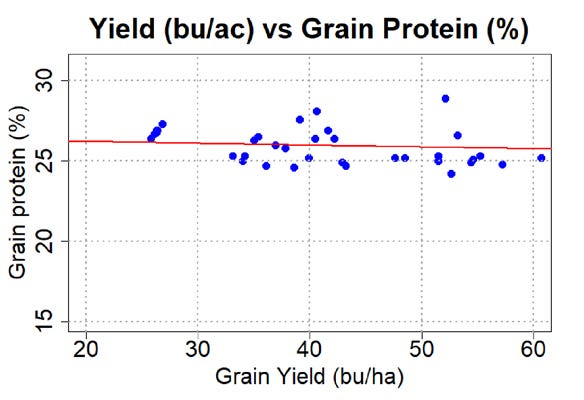
In the past 10 years, yellow field pea production in Nebraska has grown significantly. It wasn't that long ago that the pulse crop was grown by only a few farmers in western Nebraska. In 2018, about 70,000 acres in Nebraska were planted with field peas.
Many farmers have grown them as a way to break up the wheat-fallow rotation with a crop that's water-use efficient, while still making a profit and fixing nitrogen for the following wheat crop. However, while most have focused on yields and profits, some have looked into specialty markets focusing on protein content. Meanwhile, marketing opportunities have arisen from processors such as Ingredion and Puris using pea protein to make protein isolates and other food ingredients.
"For a long time, soybeans have been the major commodity for plant-based protein," says Strahinja Stepanovic, a Nebraska Extension educator who has helped answer field pea production-related questions for growers in western Nebraska.
"Recently, however, we've seen demand for non-GMO products from consumers, and trends have shown a higher demand for pea protein. Peas have a higher concentration of protein in the grain, the composition of the proteins is favorable, and the proteins are easily digestible. You can mix them easily with other ingredients."
The question is, with a pulse crop such as field peas, what factors affect protein content in the grain? What steps can growers take to emphasize protein content?
As the crop has grown in popularity, the University of Nebraska-Lincoln has conducted several studies on field pea production, highlighting the effect of different practices on protein content. Stepanovic and his colleagues recently compiled results from various studies to highlight which practices made the most difference.
This includes variety trials at three sites across Nebraska, as well as studies on fertility, tillage and irrigation, to determine the impact on protein and yield.
"In this study, the grain quality parameter we were looking at was protein," Stepanovic says. "In any given crop I've worked with, when yield goes up, protein goes down. That's not the case with peas.
"You can have 80-bushel peas and still have high protein. You can plant peas without a rhizobia inoculant, and the yield will be much lower, but the grain will have the same protein as it does with inoculant. The only difference is, with the inoculant, it will have a higher yield. It's totally different from any other crop I work with."

The easternmost site in the study, the Eastern Nebraska Research and Extension Center at Mead, saw the highest yields in 2019. The average yield was about 73 bushels per acre, with one variety yielding as high as 80 bushels per acre.
Meanwhile, dryland varieties typically yielded 33 to 52 bushels per acre at the Stumpf Wheat Research Center at Grant, while irrigated varieties at the same site averaged about 70 bushels per acre — with yields as high as 84 bushels per acre.
While yield had no observable impact on protein content, it probably comes as no a surprise that different tillage treatments (no-till and conventional tillage/disk) had no effect on protein content. Neither did different irrigation treatments (full irrigation, deficit irrigation and dryland) or fertility and inoculant treatments, which included 10 in-furrow inoculant and foliar products.
"Inoculation, however, was the most important yield-related factor, but was not related to an increase in protein," Stepanovic says. "Nontreated peas averaged 26 bushels per acre, but the protein was the same as the inoculated peas that yielded 47 bushels."
The only factor that consistently made a difference in grain protein was variety.
"There was one variety, no matter where we planted it, it stuck out above all others," Stepanovic says. "It also happened to be a high yielder. The same varieties stuck out for protein. There are four or five on top, and one, AAC Profit [from Valesco Genetics, averaged 28.1% protein], sticks out over others."
That doesn't mean growers shouldn't follow best management practices. It just means these other practices won't affect protein content.
"I'm pretty sure it's mostly driven by genetics," Stepanovic adds. "We have some good varieties like AAC Carver [from Meridian Seed] that have phenomenal yield [averaged 61 bushels per acre between the three sites], but lower protein [averaged 24.4% — almost 4% lower than the highest protein content]. So, it's good if you're shooting for yield.
"In terms of agronomic practices, if the inoculant isn't going to bump up the protein, if tillage or irrigation doesn't, it's likely that other agronomic practices like row spacing or planting date won't either."
About the Author(s)
You May Also Like






